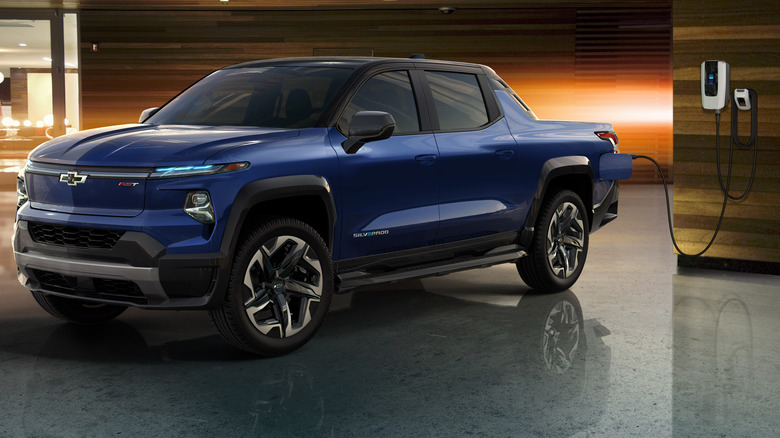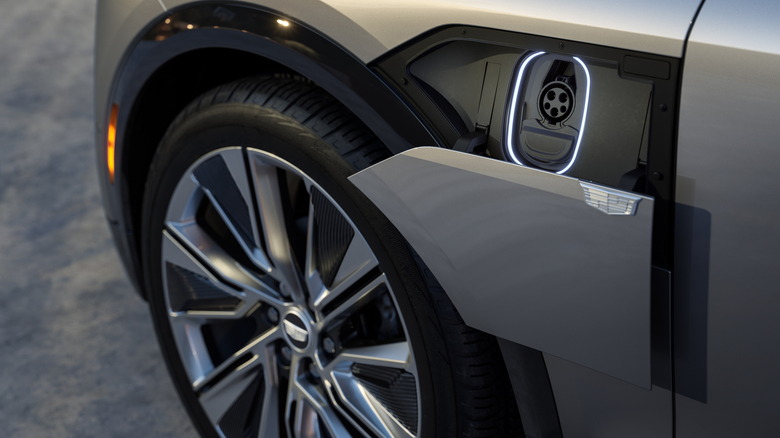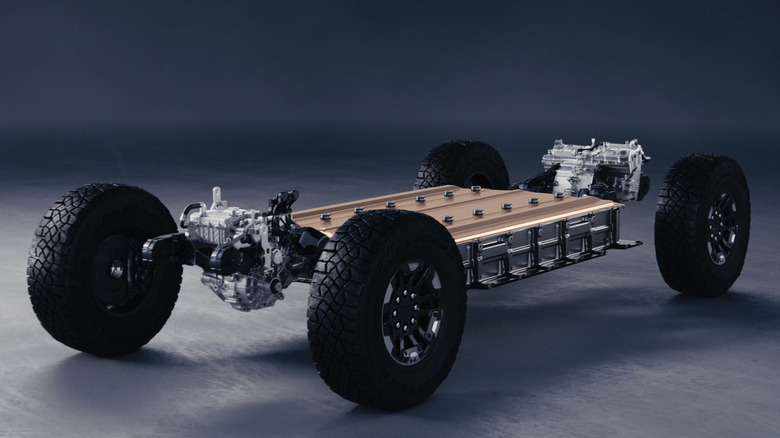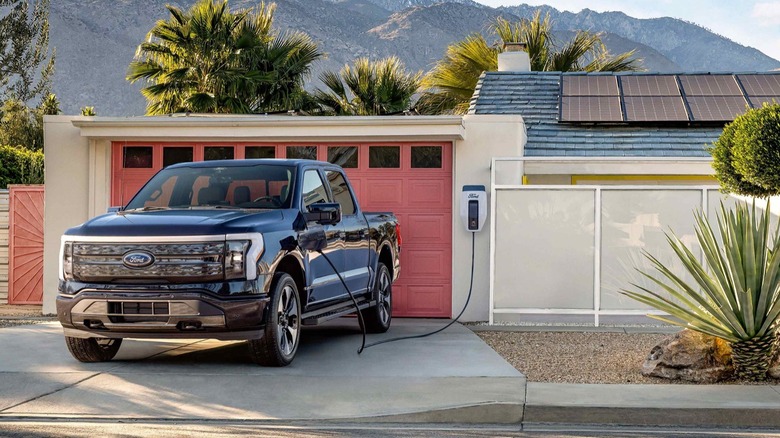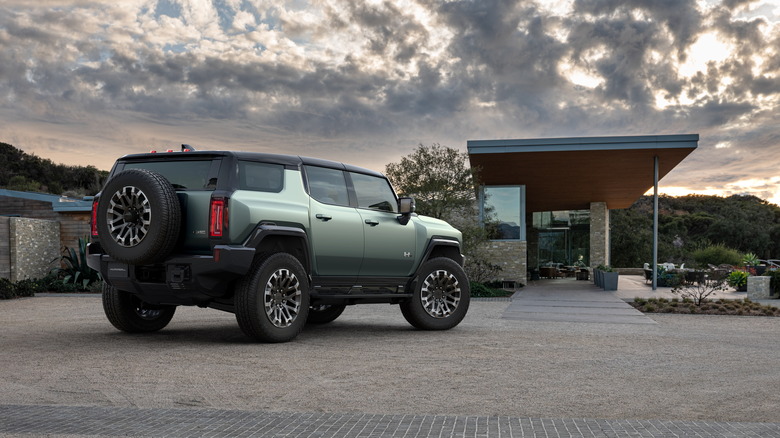GM And PG&E Pilot Will Turn Electric Cars Into Outage Saviors
General Motors and PG&E are kicking off a bidirectional charging pilot, taking advantage of the big batteries in electric vehicles to provide outage alternatives without traditional whole-home or gas generators. The collaboration will see new EV chargers that are capable of both charging a vehicle from a home's electricity supply, and of taking electricity back from the car and using it to power the home, fitted in a number of California homes before the end of 2022.
There are several ways, currently, to alleviate the impact of a power grid outage, though they can typically be complex or expensive. Whole-home generators usually run off gas, diesel, or a similar fuel, and – when correctly wired into the home – switch on automatically in the case of an outage. In recent years, meanwhile, whole-home batteries like Tesla's Powerwall have provided similar resilience, often used in tandem with solar panels to first charge them up.
Bidirectional charging takes a somewhat different approach. EV drivers typically get 80-85% of their charging needs taken care of at home, GM says, and the reality is that most of the time the vehicle is parked and idle. "The power storage in an EV battery is available 24 hours a day, seven days a week," Rick Spina, vice president of Electric Vehicle Commercialization at GM, explained to SlashGear in a briefing ahead of today's announcement.
Bidirectional charging makes the EV a Powerwall
This pilot, with energy company PG&E, will be one of the first major attempts to explore how that battery-on-wheels could be used for backup purposes, and how it might scale significantly beyond that. Over the summer, the two companies aim to design and test new EV and charger technology including "bidirectional hardware coupled with software-defined communications protocols that will enable power to flow from a charged EV into a customer's home, automatically coordinating between the EV, home and PG&E's electric supply," they said in a statement.
That will then be installed in a small number of customers' homes before larger trials begin by the end of the year. It's unclear, at this stage, how PG&E and GM will select those households eligible to take part in the pilot.
Bidirectional charging, as the name suggests, adds reverse power flow to the traditional expectations of an electric vehicle charger. It requires special hardware and software, including a so-called transfer switch in the home's power circuit that can isolate it from the main grid when the EV is providing power. The EV itself needs an upgrade, too, though GM says that's easier than you might think.
"They're not enabled to do it at this point," Spina explains. "Very shortly they will be. It's primarily software and controls that we need to do." Multiple GM electric vehicles, including models already on sale, and those fast approaching, will be utilized for the pilot. That suggests GM will be using both its existing platform, as underpins the Chevrolet Bolt EV and Bolt EUV, as well as upcoming Ultium-based models such as the GMC Hummer EV, Cadillac Lyriq, and Chevrolet Silverado EV.
V2H first, with grid ambitions later
There are actually several degrees of bidirectional charging, ranging in scope as well as complexity. GM and PG&E's pilot will focus, at least initially, on V2H, or Vehicle to Home — that's where the battery in an electric vehicle is used to power the single home it is connected to. Much as is the case with a whole-home gas generator or a Powerwall-style backup battery, in the event of a power outage by the electricity grid, the home automatically switches over to the vehicle's battery. When the grid returns, the process is reversed and the EV goes back into charging mode.
There's potential beyond that, however. V2G, or Vehicle to Grid, takes a far broader, more holistic approach to utilizing EV batteries. There, the car can not only power the home it's plugged into, but feed power back into the electricity grid itself. That could be used for what's known as load balancing, or using the EV as a "grid asset": in times of particularly high demand, such as when green sources like solar and wind can't keep up with how much power a city requires, V2G could call upon the charge in connected EVs to help make up for any shortfall.
V2G, the two companies point out, is beyond the currently-planned pilot. All the same, it's something both are considering, and there are elements of V2G which could be applied on a more individual scale with a V2H approach. "In the middle of those two, you've got a V2H situation in times where I would call 'needs for smoothing' in the grid," GM's Spina explains. "You can get this smoothing effect, if you will, when demand is very high and supply is low, you can treat it as a V2H event. And conversely, you can store the energy when it's sunny and windy as hell."
"The genesis was 'how do we make power outages invisible?'" Aaron August, Vice President of Business Development & Customer Engagement at PG&E, adds. The technology could also be used as a way to offset the sort of rolling outages that the power company was forced to undertake in 2020 when electricity demand outstripped supply. In those situations, August says, a bidirectional-capable vehicle could easily pick up the slack for the average two-hour planned outage.
GM isn't alone in exploring V2H
General Motors isn't alone in looking at this technology, of course. Ford has already announced that its fast-approaching F-150 Lightning will support V2H when paired with a custom charger the automaker will offer alongside the electric pickup. Several EVs and hybrids available in the US already offer outlets capable of running smaller loads, such as keeping a refrigerator going during a power cut.
This pilot, however, looks to keep the whole house online. "An average California home uses about 20 kWh of electricity a day," GM's Spina says. "A Chevy Bolt, as an example, has somewhere in the neighborhood of 60 kWh, 65 kWh when it's fully charged." So, you could in theory run that average home for three days, without needing to change behaviors.
That would, mind you, leave the car completely discharged. One of the elements of the pilot will be safeguards to control just how low the EV's battery is allowed to get. Currently, GM is thinking in the 50-100 mile range – "enough that you could either get to safety, or to power, depending on where that is," Spina explains – though it's envisaged as a user-adjustable setting so that homeowners will be able to dial in their own level of reassurance.
A small pilot with big aspirations
Initially, GM and PG&E will be using some proprietary hardware and software to make it all work. Down the line, though, the expectation is that the ISO 15118 standard – once finalized – will cover all those bases and, presumably, ensure interoperability between different EVs and different chargers. The pilot will also help address some of those hardware questions, along with issues like how demand management, grid control, and what sort of payout consumers could expect if their electric vehicle is used for this type of outage management.
What isn't in question is the breadth of GM's ambition for V2H and beyond. "On the vehicle side, we're intending to put it in everything," Spina says; PG&E's August concurs, adding that "on the utility side, we'd love to see them put it in everything."
While rising gas prices, questions about environmental sustainability, and the inherent driving advantages of an EV's instantaneous torque are expected to help stoke demand for electric vehicles' growth in the market, bidirectional charging and the ability to offset the impact of a power outage could end up being a wildcard. As we've seen in the US on numerous occasions now, there are times when the grid just can't keep up with demand. If an EV can step in instead, that could be the selling point skeptics need to get over their electric hesitation.
